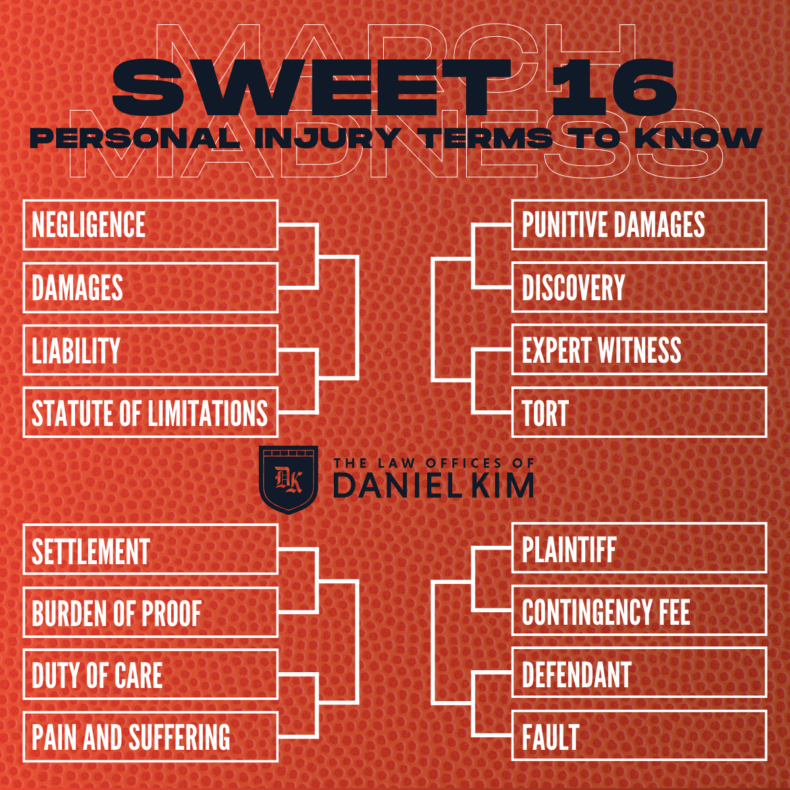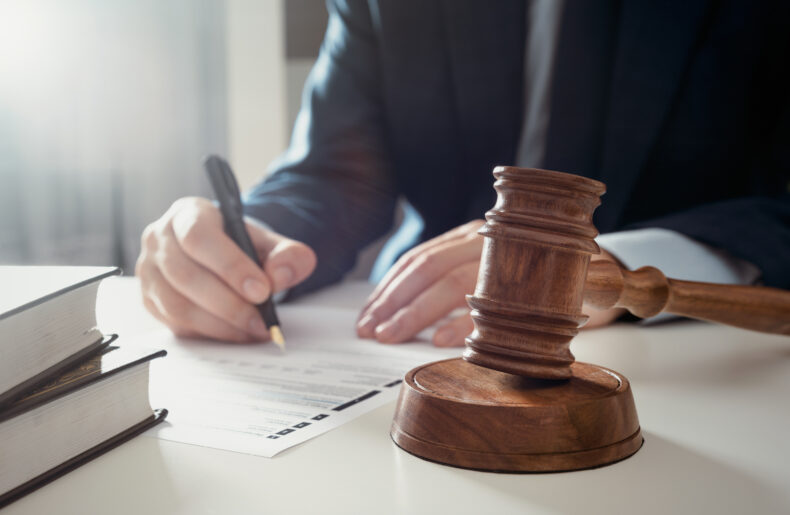Personal Injury Terms
If you are planning to or have already started the process of filing a personal injury claim, you may be confused by the legal terms that an attorney uses. Not to worry! In the spirit of March Madness, we have compiled the best of the best personal injury terms to help you navigate your case like a pro. Ready, set, go!
1. Burden of proof
The obligation placed on a party to prove their case in a legal dispute. In personal injury cases, a plaintiff usually has the burden of proof “by a preponderance of evidence,” meaning that the evidence must show it is more likely than not (50% or more) that the claim is true.
2. Contingency fee
A fee arrangement where an attorney’s compensation is based on a percentage of the amount recovered in a lawsuit. If the lawsuit is unsuccessful, the attorney does not collect a fee. Most personal injury attorneys work on a contingent fee instead of an hourly or fixed fee.
3. Damages
The legal term for monetary compensation or losses. In a personal injury case, a plaintiff seeks damages as a result of harm caused by the defendant’s negligence. Damages are typically divided into two categories: economic and non-economic.
Economic damages represent actual financial losses such as medical bills that can be proven with bills and receipts. Non-economic damages are intangible losses, such as pain and suffering, which do not have an exact dollar amount.
In rare civil cases, the plaintiff may be awarded punitive damages. These damages are meant to punish the defendant for egregious or reckless behavior.
4. Defendant
The party who is being sued in a personal injury lawsuit, accused of causing harm or injury to the plaintiff. A defendant can be an individual, a company, organization, or government entity.
5. Discovery
The pre-trial legal process where both parties in a lawsuit gather evidence from each other such as through various methods, including interrogatories, requests for documents, and depositions.
6. Duty of care
The legal obligation of a person or organization to take reasonable care in their actions or omissions to prevent injury to others. If a person does not meet the standard of care, then their actions are considered negligent.
For example, a driver has a responsibility to follow all traffic laws and operate their vehicle in a safe manner to prevent harm to other drivers, pedestrians, cyclists, etc.
7. Expert witness
A person who can testify at a trial because of their specialized knowledge or expertise in a particular field that is related to the case. For example, a neurologist might testify in a car accident case where the victim has suffered a traumatic brain injury (TBI).
8. Fault
Fault refers to responsibility for an act or omission that causes injury to another person or their property. It can be used to determine liability in a legal proceeding. Fault is commonly used in motor vehicle accidents where the question of “who is at fault?” is often the first asked.
California is considered an at-fault state. This means that whoever is at fault for the accident must pay for the damages. Under California’s pure comparative negligence law, also known as comparative fault, a plaintiff is still able to recover damages even if they are found partially at fault.
9. Liability
The legal responsibility that a person or organization has for their actions or omissions that cause harm or injury to another person or their property. If a defendant is liable in a personal injury case, then they are responsible for paying damages. Liability, negligence, and fault are often used interchangeably.
10. Negligence
The failure to take reasonable care, resulting in injury or wrongful death to another person. Another word for negligence is carelessness. Proving negligence in a personal injury case requires proving four elements:
- Duty of care
- Breach of duty of care
- Causation
- Damages
11. Pain and suffering
Physical and emotional distress that a plaintiff experiences as a result of an injury caused by the defendant’s actions or negligence. Examples of pain and suffering include anxiety, grief, shock, loss of enjoyment of life, and disfigurement.
12. Plaintiff
A party who brings a civil lawsuit against another person or organization, seeking compensation for physical or mental harm caused by the defendant.
13. Settlement
An agreement between both parties in a civil lawsuit to resolve the matter without going to trial. The terms of the settlement are usually negotiated by an attorney. Less than 3% of personal injury cases go to trial.
14. Statute of limitations
The time limit to file a personal injury claim. It is the maximum amount of time allowed to a plaintiff to file a lawsuit after an injury or harm has occurred. Under California personal injury law, accident victims have two years from the date of their accident to file a claim. Visit our blog to learn more about the statute of limitations in California.
15. Tort
A civil wrong that causes injury or harm to another person. Separate from criminal acts, torts include negligence, wrongful death, and strict liability. Tort law covers most civil litigation and the aim is to provide monetary damages as compensation.
16. Wrongful death
When a person dies from the negligent or wrongful act of another person or entity. In wrongful death claims, the surviving family members can file a lawsuit against the negligent party to seek damages for the loss. A wrongful death lawsuit can be filed in conjunction with a survival action, but is separate from a criminal action.
We Are Experienced California Personal Injury Attorneys
These common personal injury terms will help you understand your personal injury case back to front. If you or a loved one suffered injuries in a motor vehicle accident, our law firm can help you recover medical expenses, past and future income, and more. Contact a California personal injury lawyer at The Law Offices of Daniel Kim today.
CALL NOW

